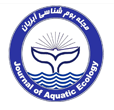1. m, R . and Gozari, M., 2024. Evaluation of the Antioxidant, Cytotoxic, and Antibacterial Activities of the Ethanolic Extract of Terminalia catappa Against Zoonotic Vibrio Species. Journal of Marine Medicine, 5(4), pp. 223-230. [
DOI:10.30491/5.4.223. (In persian)]
2. Dip, M.R.R., Sobuj, M.K.A., Islam, M.S., Akter, A., Hasan, M.M., Tasnim, N., Haque, M.A. and Rafiquzzaman, S., 2024. Phytochemicals, antioxidant and antibacterial activity of crude extract of Sargassum polycystum collected from Bangladesh. Food and Humanity, 2, p. 100278. [
DOI:10.1016/j.foohum.2024.100278]
3. Fawole, F.J., Nazeemashahul, S., Chanu, T.I., Sharma, A., Kazeem, G.O., Ferosekhan, S. and Kinnera, T., 2024. Application of Immunostimulants for Aquaculture Health Management. Immunomodulators in Aquaculture and Fish Health. CRC Press. pp. 103-115. [
DOI:10.1201/9781003361183-10]
4. Fazeli-nasab, B., Moshtaghi, N. and Forouzandeh, M., 2019. Effect of solvent extraction on phenol, flavonoids and antioxidant activity of some Iranian native herbs. Journal of Ilam University of Medical Sciences, 27(3), pp. 14-26. https://doi.org/ 10.29252/sjimu.27.3.14 [
DOI:10.29252/sjimu.27.3.14]
5. Foon, T.S., Ai, L.A., Kuppusamy, P., Yusoff, M.M. and Govindan, N., 2013. Studies on in-vitro antioxidant activity of marine edible seaweeds from the east coastal region of Peninsular Malaysia using different extraction methods. Journal of Coastal Life Medicine, 1(3), pp. 193-198. [
DOI:10.12980/JCLM.1.2013C1189]
6. Ganesan, P., Kumar, C.S. and Bhaskar, N., 2008. Antioxidant properties of methanol extract and its solvent fractions obtained from selected Indian red seaweeds. Bioresource Technology, 99(8), pp. 2717-2723. [
DOI:10.1016/j.biortech.2007.07.005]
7. Hassan, M.S.A., Elias, N.A., Hassan, M., Mocktar, N.A. and Harun, N.A., 2024. Integrated overview on status, diagnosis and disease management of Acute Hepatopancreatic Necrosis Disease (AHPND) in shrimp aquaculture through metallic nanoparticles (MNPs) application-A review. Aquaculture, p. 741649. [
DOI:10.1016/j.aquaculture.2024.741649]
8. Kakoullis, L., Papachristodoulou, E., Chra, P. and Panos, G., 2021. Mechanisms of antibiotic resistance in important gram-positive and gram-negative pathogens and novel antibiotic solutions. Antibiotics, 10(4), p. 415. [
DOI:10.3390/antibiotics10040415]
9. Kumar, V., Roy, S., Behera, B.K., Bossier, P.and Das, B.K., 2021. Acute hepatopancreatic necrosis disease (AHPND): virulence, pathogenesis and mitigation strategies in shrimp aquaculture. Toxins, 13(8), p. 524. [
DOI:10.3390/toxins13080524]
10. Leong, L. and Shui, G., 2002. An investigation of antioxidant capacity of fruits in Singapore markets. Food Chemistry, 76(1), pp. 69-75. [
DOI:10.1016/S0308-8146(01)00251-5]
11. Liu, X., 2015. Extraction and Antioxidant Activity of Phlorotannins from Edible Brown Algae. http://www.lib.ncsu.edu/resolver/1840.16/10707
12. Luthman, O., Robb, D.H., Henriksson, P.J., Jørgensen, P.S.and Troell, M. 2024. Global overview of national regulations for antibiotic use in aquaculture production. Aquaculture International, pp. 1-18. [
DOI:10.1007/s10499-024-01614-0]
13. Moon, J.-K.and Shibamoto, T., 2009. Antioxidant assays for plant and food components. Journal of Agricultural and Food Chemistry, 57(5), pp.1655-1666. [
DOI:10.1021/jf803537k]
14. Narsale, S.A., Chrisolite, B., Sivasankar, P., Subash, P., Mansoor, M., Selvamagheswaran, M., Debbarma, S., P, M.K., Baidya, S. and Kadam, R., 2024. Isolation, characterization, virulence genes, antimicrobial resistant genes, and antibiotic susceptibility pattern of Vibrio parahaemolyticus in relation to AHPND from shrimp farms in coastal districts of Tamil Nadu. Aquaculture International, 32(4), pp. 3835-3851. [
DOI:10.1007/s10499-023-01353-8]
15. Nassar, N., Sherif, M., Yushin, N. and Zinicovscaia, I., 2025. The Elemental Content of Seawater and Algae Collected from the Red Sea, the Arabian Gulf, and the Gulf of Oman: Preliminary Study. Physics of Particles and Nuclei Letters, 22(2), pp. 358-362. https://doi.org/ 10.1134/S1547477124702443 [
DOI:10.1134/S1547477124702443]
16. Pazir, M., Ahmadi, A., Nazari, M., Aein Jamshid, K., Sharifinia, M., Jafari, O. and Pourmozaffar, S., 2025. AHPND disease: An investigation of the pVA1-type plasmid characteristics of pathogenic agents. International Journal of Veterinary Research, 5(2),pp. 1-16. https://doi.org/ 10.22034/5.2.1 [
DOI:10.22034/5.2.1]
17. Praveen, N.K. and Chakraborty, K., 2013. Antioxidant and anti-inflammatory potential of the aqueous extract and polysaccharide fraction from brown marine macroalgae Padina sp. from Gulf of Mannar of Peninsular India. Journal of Coastal Life Medicine, 1(1), pp. 38-48-30. http://www.jclmm.com/qk/7.pdf
18. Rastegar, S. and Gozari, M., 2016. Antioxidant and antifungal activities of two spices of mangrove plant extract. Journal of Coastal Life Medicine, 4(10), pp. 779-783. https://doi.org/ 10.12980/jclm.4.2016J6-180 [
DOI:10.12980/jclm.4.2016J6-180]
19. Rostagno, M.A. and Prado, J.M., 2013. Natural product extraction: principles and applications. Royal Society of Chemistry. [
DOI:10.1039/9781849737579]
20. Shirani Bidabadi, K., Safaeian, S., Mousavi Nadushan, R. and Rahimifard, N., 2023. Identification of Bioactive Compounds in the Extracts of Brown Algae Sargassum (Sargassum angustifulium) and Padina) Padina distromatic (and Evaluation of Antimicrobial, Antioxidant and Enzymatic Properties. Iranian Food Science and Technology Research Journal, 19(2), pp. 259-277. https://doi.org/ 10.22067/ifstrj.2021.73113.1104
https://doi.org/10.52547/fsct.19.123.81 [
DOI:10.22067/ifstrj.2021.73113.1104]
21. Sohrabipour, J. and R. Rabiei, 2007. The checklist of green algae of the Iranian coastal lines of the Persian Gulf and Gulf of Oman. The Iran Journal of Botany, 13 (2), pp. 146-149. https://dor.isc.ac/dor/20.1001.1.1029788.1386.13.2.17.7
22. Soto-Rodriguez, S.A., Gomez-Gil, B., Lozano-Olvera, R., Aguilar-Rendón, K.G. and González-Gómez, J.P.. 2024. Identification of new Vibrio campbellii strains harboring the pVA1 plasmid isolated from Penaeus vannamei postlarvae affected by outbreaks of acute hepatopancreatic necrosis disease (AHPND) in Mexico. Aquaculture, 579, p. 740221. [
DOI:10.1016/j.aquaculture.2023.740221]
23. Stephenson, G.L., 1994. Guidance Document on Collection and Preparation of Sediments for Physicochemical Characterization and Biological Testing. Environment Canada. https://publications.gc.ca/site/eng/9.579583/publication.html
24. Taranto, F., Pasqualone, A., Mangini, G., Tripodi, P., Miazzi, M.M., Pavan, S. and Montemurro, C., 2017. Polyphenol oxidases in crops: biochemical, physiological and genetic aspects. International journal of molecular sciences, 18(2), p. 377. https://doi.org/ 10.3390/ijms18020377 [
DOI:10.3390/ijms18020377]
25. Vergara-Solana, F.J., 2024. Aquaculture and employment: Impact on livelihood and poverty. An Introduction to Sustainable Aquaculture. Routledge, pp. 225-239. [
DOI:10.4324/9781003174271-17]
26. Wang, T., Jónsdóttir, R. and Ólafsdóttir, G., 2009. Total phenolic compounds, radical scavenging and metal chelation of extracts from Icelandic seaweeds. Food Chemistry, 116(1), pp. 240-248. [
DOI:10.1016/j.foodchem.2009.02.041]
27. Wei, L.S., Sukri, S.A.M., Tahiluddin, A.B., Kari, Z.A., Wee, W. and Kabir, M.A., 2024. Exploring beneficial effects of phytobiotics in marine shrimp farming: A review. Heliyon, 10(14), e31074. https://doi.org/ 10.1016/j.heliyon.2024.e31074 [
DOI:10.1016/j.heliyon.2024.e31074]








